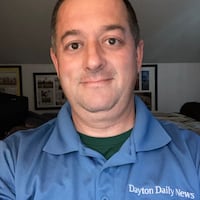This is the first offseason in the name, image and likeness era, which started in the summer of 2021, Dayton has had to rebuild such a large chunk of its roster. While coaches can, as always, sell recruits on playing in front of a sold-out arena, the NIL component is now part of the recruiting pitch. Any player visiting UD or talking to coaches will learn about Dayton 6th, the non-profit organization that launched in October with the aim of giving fans a chance to invest in the men’s and women’s basketball programs through the athletes.
“NIL is a critical component of the college basketball landscape today,” said Matt Farrell, a former UD staff member during the Brian Gregory years who serves as the director of Dayton 6th. “Whether or not people believe NIL is good or bad for college athletics, it’s here, so we don’t really have a choice but to figure out how to use it as an opportunity. We have people stepping up, but we need more people to step up. If there’s a time to step up, it’s now. The conversations in the recruiting process are real. NIL is a critical piece of conversations with transfers. It’s becoming more and more important at the high school level. I think you see that everywhere in college basketball today.”
When Dayton 6th launched in October, the UD men’s basketball program had momentum. It was the preseason favorite in the Atlantic 10 Conference and ranked 24th in the Associated Press preseason poll. Dayton battled injuries and inconsistency all season and finished 22-12, falling short of the NCAA tournament by losing to Virginia Commonwealth in the A-10 championship game.
Dayton 6th has the challenge of asking fans to continue believing in the program after a disappointing season as many struggle at the same time to deal with the changing nature of college sports, namely the roster turnover that has resulted in 1,373 players, or almost four for every Division I program, entering the transfer portal.
“We’re seeing NIL come into the college basketball world at the same time as immediate eligibility for transfers,” Farrell said, “along with the football conference Power 5 shifts in conference realignment. All of these once-in-a-generation college athletics movements are happening at once.”
Dayton has added three players to its 2023 recruiting class since the end of the season: Merrimack College transfer Javon Bennett, a 5-foot-11 point guard who announced his commitment to Dayton on Sunday; Robert Morris transfer Enoch Cheeks, a 6-3 junior guard from Providence, R.I., who committed to Dayton on March 30; and Vasilije Erceg, a 6-foot-10 forward from Novi Sad, Serbia, who committed to Dayton on March 24.
With four scholarships still open, assuming Camara doesn’t return, Dayton coaches still have to work to do in shaping the 2023-24 roster. Any potential recruit will learn about Dayton 6th, even though the coaches and the university are not involved with the organization.
Dayton Athletic Director Neil Sullivan encouraged fans to support Dayton 6th in an email to season-ticket holders in November.
“Third-party NIL crowdfunding opportunities are growing dramatically, often referred to as ‘collectives’ to provide compensation to players separate from their institution,” Sullivan wrote. “Fan bases from Notre Dame to Ohio State to Gonzaga have announced such fan clubs. Per NCAA regulations, schools have no formal control over these third-party entities or their finances. The concept is for fans to pool together ‘collectively’ and assemble money in a common portfolio managed to the benefit of student-athletes to perform legitimate services using their name, image and likeness. It is a way for ALL fans, at every contribution level— no matter how big or small — to invest in student-athletes.”
Dayton 6th allows fans to directly contribute money to the athletes. It also connects corporations and business leaders to the athletes. For example, Ron Morton, H&R Block’s largest franchisee with 74 locations across eight states, announced the largest corporate full-team name, image and likeness opportunity for Dayton men’s basketball in January. There are also “major gifts,” what Farrell describes as “bigger checks from individuals or business owners who have a purpose in what they’re trying to achieve.”
“I would say that all of those have advanced significantly over the last six months,” Farrell said, “and at the end of the day, it’s important to acknowledge the success that we’ve had as a community around that.”
At the same time, in looking ahead, Farrell said, “All that what we’ve done and all the wins we’ve had to date are not enough for where we’re going. We need to look forward and understand that this is becoming becoming a critical component. It is equally as important of a component as facilities, as the nutrition and strength programs, as the academic programs and fan support. It’s not more important than any one of those, but it is now in the conversation alongside all the other things.”
About the Author

